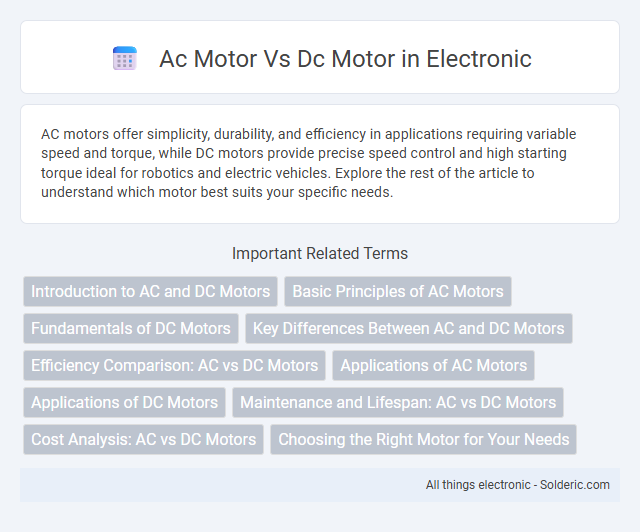AC motors offer simplicity, durability, and efficiency in applications requiring variable speed and torque, while DC motors provide precise speed control and high starting torque ideal for robotics and electric vehicles. Explore the rest of the article to understand which motor best suits your specific needs.
Comparison Table
| Feature | AC Motor | DC Motor |
|---|---|---|
| Power Source | Alternating Current (AC) | Direct Current (DC) |
| Speed Control | Complex, requires variable frequency drives | Simple, adjustable via voltage or current |
| Maintenance | Low due to absence of brushes (in induction motors) | High due to brushes and commutators |
| Efficiency | Generally high, especially in induction motors | High, varies with type and load |
| Torque | Reduced starting torque (in induction motors) | High starting torque |
| Applications | Household appliances, industrial machines, HVAC | Electric vehicles, cranes, elevators, robotics |
| Cost | Lower initial cost, cheaper maintenance | Higher initial cost, more maintenance needed |
Introduction to AC and DC Motors
AC motors operate using alternating current, which reverses direction periodically, making them suitable for household appliances and industrial applications due to efficient speed regulation and durability. DC motors run on direct current with a constant polarity, offering precise speed control and high starting torque, ideal for robotics and electric vehicles. The fundamental difference lies in their power source, influencing design, performance, and application scope.
Basic Principles of AC Motors
AC motors operate based on the principle of electromagnetic induction, where an alternating current supplied to the stator winding generates a rotating magnetic field. This rotating field induces an electromotive force in the rotor, causing it to turn and produce mechanical motion. Key types of AC motors include induction motors and synchronous motors, both widely used in industrial and household applications due to their efficiency and reliability.
Fundamentals of DC Motors
DC motors operate by converting direct current electrical energy into mechanical energy through the interaction of a magnetic field and armature winding. The fundamental components include a stator, which provides a constant magnetic field, and a rotor (armature) that carries current and rotates under electromagnetic force. Understanding your DC motor's key elements like commutators and brushes is essential for efficient control and maintenance.
Key Differences Between AC and DC Motors
AC motors operate on alternating current and typically feature simpler construction, making them ideal for high-speed applications and variable loads. DC motors run on direct current, offering precise speed control and high starting torque due to their commutation system. Key differences include the power source, speed control mechanisms, maintenance requirements, and typical applications in industries such as manufacturing and robotics.
Efficiency Comparison: AC vs DC Motors
AC motors generally offer higher efficiency in industrial applications due to their simpler construction and lower maintenance requirements, especially in variable speed operations. DC motors, while providing excellent speed control and torque characteristics, tend to have lower efficiency because of brushes and commutators causing energy loss. Your choice between AC and DC motors should consider efficiency alongside operational demands and performance needs.
Applications of AC Motors
AC motors are widely used in HVAC systems, industrial machinery, and household appliances due to their efficiency and durability. They are ideal for applications requiring constant speed and high power output, such as conveyor belts, pumps, and fans. Your choice of AC motors supports reliable performance in both commercial and residential settings, maximizing operational efficiency.
Applications of DC Motors
DC motors are widely used in applications requiring precise speed control and high starting torque, such as electric vehicles, robotics, and industrial machinery. Their ability to provide consistent torque at varying speeds makes them ideal for conveyor belts, cranes, and elevators. Additionally, DC motors are preferred in battery-operated devices and small household appliances due to their efficiency and controllability.
Maintenance and Lifespan: AC vs DC Motors
AC motors generally require less maintenance than DC motors due to fewer moving parts and the absence of brushes and commutators, which reduces wear and tear. DC motors typically have a shorter lifespan because brushes and commutators wear down over time, necessitating regular servicing and replacement. The robust design and simpler construction of AC motors contribute to longer operational life and lower maintenance costs in industrial applications.
Cost Analysis: AC vs DC Motors
AC motors generally have lower initial costs due to simpler construction and manufacturing processes compared to DC motors, which require brushes and commutators. Maintenance expenses for DC motors tend to be higher because of brush wear and replacement, impacting long-term operational costs. Energy efficiency variations also influence overall costs; AC motors often exhibit better efficiency in industrial applications, reducing electricity consumption and lowering lifetime expenditures.
Choosing the Right Motor for Your Needs
Selecting between an AC motor and a DC motor depends on application-specific requirements such as speed control, efficiency, and maintenance. AC motors offer durability and lower maintenance for continuous operation, ideal for industrial machinery, while DC motors provide precise speed control suitable for robotics or electric vehicles. Evaluating factors like torque demands, power source availability, and operational environment ensures the optimal motor choice to maximize performance and cost-effectiveness.
ac motor vs dc motor Infographic

 solderic.com
solderic.com